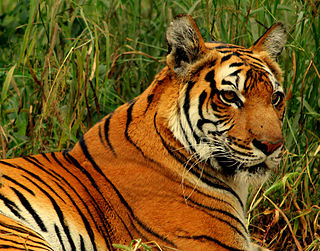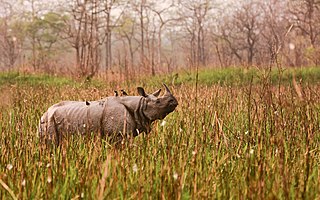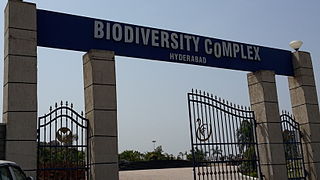
The Convention on Biological Diversity (CBD), known informally as the Biodiversity Convention, is a multilateral treaty. The Convention has three main goals: the conservation of biological diversity ; the sustainable use of its components; and the fair and equitable sharing of benefits arising from genetic resources. Its objective is to develop national strategies for the conservation and sustainable use of biological diversity, and it is often seen as the key document regarding sustainable development.

Biodiversity is the variability of life on Earth. It can be measured on various levels. There is for example genetic variability, species diversity, ecosystem diversity and phylogenetic diversity. Diversity is not distributed evenly on Earth. It is greater in the tropics as a result of the warm climate and high primary productivity in the region near the equator. Tropical forest ecosystems cover less than one-fifth of Earth's terrestrial area and contain about 50% of the world's species. There are latitudinal gradients in species diversity for both marine and terrestrial taxa.

Protected areas or conservation areas are locations which receive protection because of their recognized natural or cultural values. Protected areas are those areas in which human presence or the exploitation of natural resources is limited.
In-situ conservation is the on-site conservation or the conservation of genetic resources in natural populations of plant or animal species, such as forest genetic resources in natural populations of tree species. This process protects the inhabitants and ensures the sustainability of the environment and ecosystem.
Rio Convention relates to the following three conventions, which were agreed at the Earth Summit held in Rio de Janeiro in June 1992.

India is the world's 8th most biodiverse region with a 0.46 BioD score on diversity index, 102,718 species of fauna and 23.39% of the nation's geographical area under forest and tree cover in 2020. India encompasses a wide range of biomes: desert, high mountains, highlands, tropical and temperate forests, swamplands, plains, grasslands, areas surrounding rivers, as well as island archipelago. Officially, four out of the 36 Biodiversity Hotspots in the world are present in India: the Himalayas, the Western Ghats, the Indo-Burma and the Nicobar Islands. To these may be added the Sundarbans and the Terrai-Duar Savannah grasslands for their unique foliage and animal species. These hotspots have numerous endemic species. Nearly 5% of India's total area is formally classified under protected areas.

Orang National Park is a national park in India located on the northern bank of the Brahmaputra River in the Darrang and Sonitpur districts of Assam. It covers an area of 79.28 km2 (30.61 sq mi). It was established as a sanctuary in 1985 and declared a national park on 13 April 1999. It is rich in flora and fauna, including great Indian rhinoceros, pygmy hog, Asian elephant, wild water buffalo and the Bengal tiger. It is the only stronghold of the rhinoceros on the north bank of the Brahmaputra.

A biodiversity action plan (BAP) is an internationally recognized program addressing threatened species and habitats and is designed to protect and restore biological systems. The original impetus for these plans derives from the 1992 Convention on Biological Diversity (CBD). As of 2009, 191 countries have ratified the CBD, but only a fraction of these have developed substantive BAP documents.

India is one of the most biodiverse regions and is home to a large variety of wildlife. It is one of the 17 megadiverse countries and includes three of the world's 36 biodiversity hotspots – the Western Ghats, the Eastern Himalayas, and the Indo-Burma hotspot.

The Living Planet Index (LPI) is an indicator of the state of global biological diversity, based on trends in vertebrate populations of species from around the world. The Zoological Society of London (ZSL) manages the index in cooperation with the World Wide Fund for Nature (WWF).

The environment of India comprises some of the world's most biodiverse ecozones. The Deccan Traps, Gangetic Plains and the Himalayas are the major geographical features. The country faces different forms of pollution as its major environmental issue and is more vulnerable to the effects of climate change being a developing nation. India has laws protecting the environment and is one of the countries that signed the Convention on Biological Diversity (CBD) treaty. The Ministry of Environment, Forest and Climate Change and each particular state forest departments plan and implement environmental policies throughout the country.

The Biodiversity Indicators Partnership (BIP) brings together a host of international organizations working on indicator development, to provide the best available information on biodiversity trends to the global community. The Partnership was initially established to help monitor progress towards the Convention on Biological Diversity (CBD) 2010 Biodiversity target. However, since its establishment in 2006 the BIP has developed a strong identity not only within the CBD but with other Multilateral Environmental Agreements (MEAs), national and regional governments and other sectors. As a result, the Partnership will continue through international collaboration and cooperation to provide biodiversity indicator information and trends into the future.
The World Wide Views projects were started in 2009 by the Danish Board of Technology Foundation to involve citizens in global environmental policy making through deliberation and voting.

The International Year of Biodiversity (IYB) was a year-long celebration of biological diversity and its importance, taking place internationally in 2010. Coinciding with the date of the 2010 Biodiversity Target, the year was declared by the 61st session of the United Nations General Assembly in 2006.
The United Nations General Assembly had declared 2011–20 the United Nations Decade on Biodiversity. The UN Decade on Biodiversity had served to support and promote implementation of the Strategic Plan for Biodiversity and the Aichi Biodiversity Targets, with the goal of significantly reducing biodiversity loss. None of the 20 aichi targets were achieved, though progress was made towards several of them.
Formed in 2000 and launched globally in 2005, the Alliance for Zero Extinction (AZE) comprises 100 non-governmental biodiversity conservation organizations working to prevent species extinctions by identifying and safeguarding sites where species evaluated to be Endangered or Critically Endangered under International Union for Conservation of Nature (IUCN) criteria only exist at one location on Earth. AZE members work to rebuild populations of endangered and critically endangered species through efforts to eliminate human threats such as commercial exploitation, disease and the introduction of invasive species. AZE provides expertise on biodiversity goals for the Convention on Biological Diversity (CBD) and assists party nations in integrating protection of AZE sites and species into National Biodiversity Strategies and Action Plans (NBSAP). Country-based initiatives, or national Alliances for Zero Extinction, have begun to take shape recently representing partnerships of government agencies and non-government organizations to accelerate the protection of AZE sites in compliance with national commitments under the Convention on Biological Diversity.

The Biodiversity Park in Gachibowli, Hyderabad was established during the Convention on Biological Diversity held in 2012. It was inaugurated along with a commemorative pylon by the Prime Minister of India, Manmohan Singh. It was thrown open to the public on 19 January 2015. The park was set up within the Telangana State Industrial Infrastructure Corporation (TSIIC) Layout at a cost of Rs. 2 crores. It is 1.6 km from Raidurg metro station.

Elizabeth Maruma Mrema is a Tanzanian biodiversity leader and lawyer, living in Montreal, Canada, who has been serving as Deputy Executive Director of the United Nations Environment Programme (UNEP) since 2023, under the leadership of Executive Director Inger Andersen.

The 2022 United Nations Biodiversity Conference of the Parties (COP15) to the UN Convention on Biological Diversity (CBD) was a conference held in Montreal, Canada, which led to the international agreement to protect 30% of land and oceans by 2030 and the adoption of the Kunming-Montreal Global Biodiversity Framework.

The Kunming-Montreal Global Biodiversity Framework (GBF) is an outcome of the 2022 United Nations Biodiversity Conference. Its tentative title had been the "Post-2020 Global Biodiversity Framework". The GBF was adopted by the 15th Conference of Parties (COP15) to the Convention on Biological Diversity (CBD) on 19 December 2022. It has been promoted as a "Paris Agreement for Nature". It is one of a handful of agreements under the auspices of the CBD, and it is the most significant to date. It has been hailed as a "huge, historic moment" and a "major win for our planet and for all of humanity."















